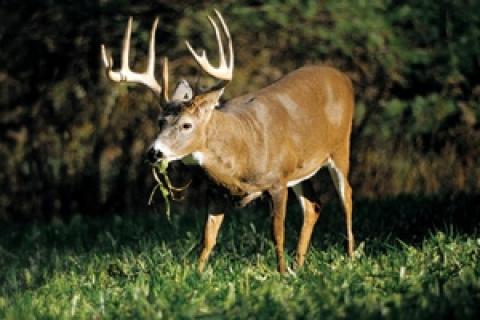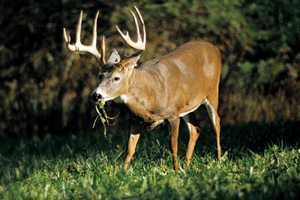
 Giving up on the rut is one of the biggest mistakes a deer hunter can make. And, it happens all the time. They see a lot of chasing and grunting and four bucks marching past their stand in a morning sit, and then things go quiet. They sit a day or two longer, see very little activity, declare "rut over", pack up, and go home. If this sounds familiar, read on because you just may be missing some of the best hunting of the season.
Giving up on the rut is one of the biggest mistakes a deer hunter can make. And, it happens all the time. They see a lot of chasing and grunting and four bucks marching past their stand in a morning sit, and then things go quiet. They sit a day or two longer, see very little activity, declare "rut over", pack up, and go home. If this sounds familiar, read on because you just may be missing some of the best hunting of the season.
Best Time to Hunt or Hit and Miss
The rut can be the best and worst of times and is best described as a hit and miss proposition. One day bucks are running everywhere and you think you have entered big buck heaven. The next you see nothing but a couple of does and fawns, and the next and the next after that.
Marauding bucks have been known to cover miles in a 24-hour period. They range hither and yon looking for does. Often, they cover their core territories (and a little bit more) in the course of a single day. That's when you are seeing bucks coming and going all day long. That's when the hunting is great and you want to be out there covering neck downs, ridges, transitions between cover types, and anywhere else a buck is likely to show up.
But that's what typically happens during the pre-breeding part of the rut. During the actual breeding period, bucks often "lock down" with does and stay put in the same clearcut, or CPR field or other out-of-the-way area for two to three days. Oft times they stay within a half acre or less. Grown over clearcuts, old abandoned fields, uncut cornfields, swamp islands, and a host of similar locations are all favorites of breeding whitetails. This can tie up a buck (often multiple bucks) for a couple of days during prime deer hunting time. When breeding is at it's peak, the only time a mature buck will move is when he leaves one doe for another. This leads to less than great hunting and cries of "rut over" by hunters.
Nothing could be farther from the truth. The peak of the whitetail breeding season typically stretches out over a few weeks in the middle of November and the good bucks are still out there searching for estrus does. Mature bucks abandon their nocturnal ways, and are moving from doe group to doe group searching for estrus does. The trouble is, in doe dense areas, they don't have to do a whole lot of searching before they find what they are looking for. Actually, the breeding season stretches out over a few months but the majority of does are bred within a few weeks, or the peak of the biological rut.
Giving up on the rut after a few quiet sits in the woods is a common mistake made by hunters. It pays to hang tough because the rut is still your best chance of catching a smart old whitetail out and about with a body full of testosterone and a nose full of pheromones; this is a killable buck because his need to breed has overcome his natural need to stay alive. Sooner or later he will wander by and give you the chance of a lifetime. The trick to hunting the whitetail rut is putting in the time to catch that buck of your dreams with his guard down and about the only time that occurs is during the rut.
How Do You Know When the Rut is Over?
As a wise philosopher once proclaimed, "It ain't over till it's over." But how do you know when it's over? When is the breeding done and when do whitetails get back to normal behavior patterns? For starters, you can check your calendar and look for the rut to end sometime in late November to early December. But that only gives you an approximate time period. You need to do better than that.
A sure sign that the rut is about over is when does reunite with their fawns. Breeding typically breaks up doe/fawn units as the incessant buck pressure forces does and fawns apart. Fawns are wandering all over the woods looking for momma. They will be back together as soon as the doe is bred and the buck leaves her.
Does also quit using commonly used food sources like food plots and planted fields when the rut is on; bucks patrol these areas and does learn to avoid them. When buck pressure subsides the does are back on the food and busy loading up for the winter ahead. When the breeding period subsides, you'll see feeding areas begin to load up again with does and fawns.
Bucks also return to heavy feeding once the rut has run its course. Bucks typically loose 20-25 percent of their body weight over the course of the rut and they have a brief period of time to put the weight back on before the onslaught of winter. They typically rest a few days after all the hard breeding and then take to the food. Multiple bucks feeding in a field is a sure sign of rut over.
Another sure sign is older aged bucks hanging together. Bucks that battle for breeding rights often group back up when there is no breeding to be had. Obviously, they don't bear a grudge over all the fighting and posturing that went on over the past month.
Bucks will also stop acting stupid. As testosterone subsides, a buck's brain starts functioning again. Mature bucks stop parading around in daylight hours, quit raking trees, and stop fighting with anything that looks crosswise at them. They return to nocturnal movement patterns (unless extremely cold), and become extremely hard to hunt.
A hot doe can show up at any time and then it all starts up over again but as the hot does become fewer and fewer the urge to reproduce gives way to the urge to stay alive and food becomes the key.
All in all the rut is still a great time to be in the woods. The trick is to hang tough and keep hunting as anything can happen and often does. That said, when the rut finishes it's time to adjust tactics accordingly. There is a big difference between hunting "the need to breed" and "the need to feed". Savvy hunters know when to hold their rut cards and when to fold em.
- 24489 views

